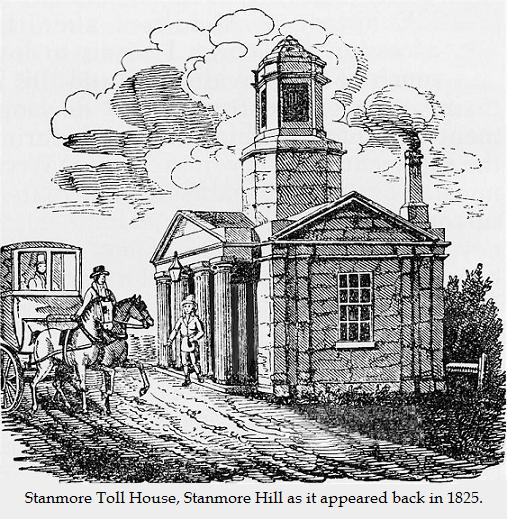An excerpt from William Hove’s “Everyday Book” of 1838
Stanmore Toll House, its ornamental look and public use combine to render it worth observation. Our new toll houses are deservedly the subject of frequent remark, on account of their beauty. The preceding engraving is intended to convey the idea of Stanmore gate which is one of the handsomest near London . The top is formed into a large lantern which when illuminated it is an important mark to drivers in dark nights.
Since Roman times the road between London and St. Albans has always been an important one. The Roman town of Sulloniacae lay exactly half-way between London and St. Albans, where Stanmore is now. The road was certainly important in the Middle Ages, and from time to time various grants of tolls and pavage were made to further its repair.
The 18th century saw the introduction of the Turnpike on many of the major highways of the country. Tollgates, or ‘turnpikes’, were erected in order to levy tolls on all road users, with the exception of pedestrians, and were administered by Trusts, the tolls going towards the upkeep of the road. The turnpike roads were a great improvement over the previous muddy tracks as they had properly constructed surfaces that were kept in good order, thus enabling people and cargoes to be transported more speedily.
Two turnpikes passed through Watford, which no doubt had an important impact on the growth of the inn trade. The first was the Aylesbury to Bushey Heath turnpike which was run by the Sparrow’s Herne Trust and was in operation from 1762 to 1872. It had two tollgates in the vicinity of Watford. One stood in Hempstead Road at the bottom of Ridge Lane, where Toll Gate Lodge stands, and the second was located at Bushey Arches, where a cast iron marker post still survives.
A petition to the Commons in 1711 stated that the part of the London-Watford road from Great Stanmore to Kilburn, which included a section of Watling Street in Edgware parish between Canons and Edgware Bridge, was so damaged by the multitude of carriages and passengers that it was almost impassable for six months of the year, and in the same year the Edgware-Kilburn turnpike trust was established.
These type of Brick toll houses were built at a cost of around £25 each. Tollkeepers were appointed and paid 10s 6d a week although for that they had to pay for the oil for the night time illumination of the gates and lamps themselves and man the gates 24hrs a day.
From the 18th century, Stanmore Hill became a major through-route as shown by the establishment of public houses and hotels, such as The Abercorn Arms and The Vine along Stanmore Hill was built c.1840, but an earlier public house on the site was licensed by 1751 and would have served the passing trade. The Stanmore tollhouse was erected near the top of Stanmore Hill close to the vine.
In 1762 the maximum rate for tolls were:
Horse or beast drawing a coach - 3d
Pack horse (laden) - 1½d
Drove of oxen, cows etc. - 10d per score
Drove of sheep, calves, swine - 5d per score.
The various Turnpike trusts were absorbed into the Metropolitan Turnpike Roads Trust in 1827 and eventually the road was disturnpiked in 1872 as use declined with the coming of the railways in the mid 19th century.
